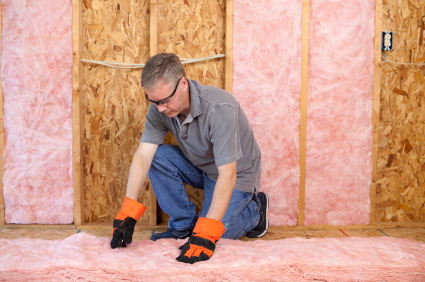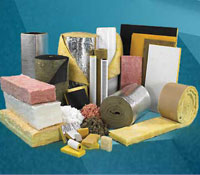Lesson: Winter Insulation
(Lesson courtesy of Teachengineering and the Integrated Teaching and Learning Program, College of Engineering, University of Colorado at Boulder. Lesson PDF )
Grade Level: 3-8
Time Required: 50 minutes
Group Size: 3
Cost Per Group: US$ 4
Overview
When a room feels too cold or hot, your first response might be to adjust the thermostat, but an engineer may question whether the building has been properly insulated to avoid energy waste and high utility bills. In this lesson, students in grades 3 through 8 assume the role of building engineers, testing several materials to determine which would provide the best house insulation. They learn about the role of insulation in preventing heat transfer and discuss the importance of energy conservation in buildings.
Learning Objectives
After this activity, students should be able to:
- Describe how insulation works.
- Demonstrate how some materials insulate better than others
- Relate that effective insulation helps conserve energy.
- Describe how energy engineers use insulation when designing products.
Engineering Connection
The heating and cooling of buildings uses a lot of energy, so engineers continually look for creative ways to reduce the heating and cooling demands, and thus the total amount of energy required. One way to do this is by using insulation. Today, engineers have developed many types of insulation such as fiber glass, rock wool, mineral wool, natural wool, cotton, straw, cellulose, paper, polyurethane foam, polystyrene foam, polyester and soy foam. Some insulating materials are suitable for sound proofing, too.
Vocabulary
Energy conservation: The wise and efficient use of energy resources, resulting in reduced energy usage.
Insulation: A non-conductive material or substance used to prevent the transfer of heat, electricity, or sound.
Scientific method steps: 1) Form a hypothesis, 2) Make predictions for that hypothesis, 3) Test the predictions, and 4) Reject or revise the hypothesis based on the research findings.
Other keywords: energy, energy savings, heat loss, nonrenewable, renewable, scientific method, temperature, thermometer
Educational Standards
Colorado Math. Grades 0 – 4, 2005
Construct, read, and interpret displays of data including tables, charts, pictographs, and bar graphs
Know, use, describe, and estimate measures of length, perimeter, capacity, weight, time, and temperature
Colorado Science. Grades 0 – 12, 1995
Standard 1: Students understand the processes of scientific investigation and design, conduct, communicate about, and evaluate such investigations.
Standard 2.2: Students know that energy appears in different forms, and can be transferred and be transformed.
Standard 5: Students know and understand interrelationships among science, technology, and human activity and how they can affect the world.
Materials
Each group needs:
- 4 plastic water or soda bottles (~591 ml or 20 oz size)
- Hot tap water
- Thermometer (Fahrenheit scale)
- Newspaper
- Wool sock
- Large piece of aluminum foil (enough to wrap around a bottle)
- Large piece of thick, black plastic bag (enough to wrap around a bottle)
- Tape
- Stop Heat from Escaping Worksheet
Background
Conserving energy means using energy wisely and efficiently, but there are many ways we waste energy by not using it wisely. Buildings often waste great amounts of energy, with most of the energy use being put to heating or cooling the building. One way engineers reduce the amount of energy required to heat or cool a building is by using good insulation.
Insulation is a material or substance used to prevent the transfer of heat, electricity or sound. In a building, insulation is placed in the walls and roof. When insulating a building, the quality of an insulation material is measured by how well it keeps heat out. Typically, heat flows from warm areas to cool areas. When you touch something cold, heat is actually leaves your body to try and warm the cool surface, creating a balance of energy. Insulation helps to prevent that transfer of heat.
There are many different materials used for insulation. Engineers often use fiber glass, wool, cotton, paper (wood cellulose), straw and various types of foams to insulate buildings. A layer of trapped air can serve as insulation, too! Some insulating materials are suitable for sound proofing, as well.
Procedure
Safety: Remind students that glass thermometers are breakable and work with caution when handling the heated water.
Troubleshooting Tips
- If hot water is not available, use water chilled with ice.
- Have a digital thermometer handy in case the change in temperature is not large enough to be read from a regular thermometer.
Before the Activity
Gather materials and make copies of the Stop Heat from Escaping Worksheet.

With the Students
1. Introduce the activity by providing students with information about building energy use and insulation. Explain that the class will conduct a engineering investigation to determine the type of material that would best insulate a house — wool, newspaper, aluminum foil, or a plastic bag. Review the steps of a scientific investigation using the vocabulary section above. Remind students that engineers need to understand energy conservation concepts to design more effective home energy systems.
2. Divide the class into teams of two to four students each, providing each team with a worksheet.
3. On the board, write a problem question that will be addressed today, such as: Which type of insulation would keep my house warmest in the winter?
4. Show students the four insulation materials to be tested — wool, newspaper, aluminum foil, and plastic bags. Ask them to hypothesize which they think will be the best insulating material. Have them circle their predictions on their worksheets.
The following steps can be performed as a demonstration by the teacher — particularly for younger students — or by groups of students. If the latter, be sure students are wearing protective lab gloves. Have group members determine ahead of time who will be responsible for which tasks.
1. Wrap the four plastic bottles with equal amounts of each material to serve as insulators.
2. Pour equal amounts of hot tap water into each bottle.
3. Immediately after the hot water is poured in the bottle, measure its temperature. Record these beginning temperatures on the worksheets.
4. Have students pause for 15 minutes to draw the diagram of their set-up on their worksheets.
5. After 15 minutes, direct students to measure and record the current temperature of the water in each bottle.
6. Next, to calculate the change in temperature for each bottle, students should subtract the ending temperature from the beginning temperature.
7. Which material was the best insulator based on the student data? Which had the smallest change of temperature? What material(s) would the students recommend? If groups reached different conclusions, take a poll to find out which materials worked best overall. As a class, agree on a concluding statement for the experiment based on everyone’s research findings. Solicit suggestions from students as to other materials they could use, ways to extend or refine the test, and other possible insulation tests they could conduct.
Assessment
Pre-Activity Assessment
Drawing: Have the students draw pictures of a typical summer clothing outfit and a typical winter clothing outfit. As a class, discuss the differences and why.
Discussion: How do clothes serve as insulation for the human body? Ask the students what type of clothes they wear in the summer and what they wear in the winter? What is the difference between the clothing? Possible answers: Summer clothes allow the heat created by our bodies to dissipate into the surrounding air. Winter clothes, such as heavy winter jackets, sweaters, mittens and hats, trap our body’s heat to keep us warm.
Activity Embedded Assessment
Worksheet: Have the student teams complete the Stop Heat from Escaping Worksheet to guide them through the activity. Review their answers to gauge their mastery of the concepts.
Post-Activity Assessment
Discussion: Which material provides the best insulation? Which would you wear to keep warm in the winter? We all use too much energy. If we were to reduce the amount of energy we use each day, then we would cause less pollution of the environment and our fossil fuels would last longer. Engineers find many ways to conserve energy in our homes, schools and offices. If we built houses with better insulation, less heat would escape through the walls, roof and windows. Light bulbs with lower energy demand also help conserve energy.
Insulation Application: Insulation prevents the transfer of heat, electricity or sound. Have students design a different product using insulation. How many things can they think of that would use the idea of insulation? Examples include a swimming pool, a house in an extreme environment, clothing, ear plugs, a coffee mug, an electric plug or an auditorium.
Extensions
- Follow the same procedure using ice-cold water.
- Have students measure the temperature on the inside and outside of the bottle and examine the transfer of heat through the insulating material.
- Have students research the types of materials used in the construction of buildings and houses, coffee mugs, and winter jackets. What different kinds of challenges do each of these items present? What kinds of innovations have been developed recently?
- Using the information learned from this activity, have students create small model homes using the insulation materials, and test the temperature readings on the inside and outside.
- Assign students to explore the eGFI student blog for stories on energy-efficient buildings, like the proposed “green” Philadelphia Eagles’ stadium and the sun and wind-powered Dragonfly tower envisioned for New York City. What are the advantages — and disadvantages, or challenges — of such structures?
Activity Scaling
- To add a math component, have students measure the water temperature every five minutes and create a graph showing temperature vs. time.
- To add a math component, have students report/plot temperature in degrees Celsius or Kelvin, instead of Fahrenheit
References
- EERE Consumer’s Guide: Your Home: Insulation and Air Sealing. Content last updated September 12, 2005. Energy Savers, Office of Energy Efficiency and Renewable Energy, U.S. Department of Energy. Updated January 9, 2019
- Energy Conservation: Yesterday and Today, Chapter 5. Renewable Energy Curriculum, TVA Kids for Teachers, Tennessee Valley Authority. Accessed September 21, 2005. http://www.tvakids.com/teachers/pdf/elementary_ch5.pdf
Contributors: Sharon D. Perez-Suarez, Natalie Mach, Malinda Schaefer Zarske, Denise Carlson. © 2005 by Regents of the University of Colorado. Integrated Teaching and Learning Program, College of Engineering, University of Colorado at Boulder
Filed under: Class Activities, Grades 6-8, Grades 6-8, Grades K-5, Grades K-5, Lesson Plans
Tags: Architectural, Class Activities, Environmental Engineering, Grades 3-8, Grades K-5, Green, Green Technology









